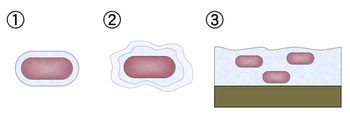Glycocalyx
| Parent |
| Cell periphery |
| Gene Ontology |
|---|
| QuickGO |
The glycocalyx is a layer on the outer surface of the cell membrane in eukaryotic and prokaryotic cells , but also on the outside of the cell wall in prokaryotic cells . The glycocalyx is also called a capsule or mucous membrane , whereby the capsule and mucous membrane differ in detail. The capsule is firmly attached to the cell wall; this does not apply to the mucous covering. The glycocalyx consists of polysaccharides that are covalently bound to the membrane proteins ( glycoproteins ) and membrane lipids ( glycolipids , phospholipids , cholesterol and sphingolipids ).
General
Living cells, both from prokaryotes and eukaryotes, are enveloped by a membrane , the cell or plasma membrane. In a sense, it represents a semi-permeable border to the "external environment". Almost all biological membranes have a layer of sugar residues of varying thickness on their surface. The glycocalyx consists of oligosaccharides which are covalently bound to almost all membranous proteins (then glycoproteins ), but also to a smaller number of lipids (then glycolipids ) . Sugar residues are only a limited number of sugars, namely glucose , fucose , mannose , glucosamine , sialic acids and galactosamine . The sialic acids cause a negative charge on the cell membrane surface (see cathode ). The glycocalyx is renewed regularly. It should be noted that there is no glycocalyx in plants.
Its thickness can vary and it can occur in both gram-positive and gram-negative bacteria ( Gram stain ). The capsule can greatly increase the volume of the bacteria. All other cell wall layers remain under the capsule layer.
In biomembranes, 90% of this branched sugar is attached to membrane proteins and 10% to glycolipids.
In the glycocalyx of animal cells or tissue in particular , five phylogenetically highly conserved molecules or families of molecules that are important for intercellular communication (cell recognition, contact and adhesion) can be distinguished: immunoglobulins , integrins , cadherins , selectin and cell adhesion molecules .
A large number of the members of the individual molecule families are related to the microfilament system of the cells or are coupled to GTP-binding proteins from the cell membrane, others are related to the MAP kinase pathway .
meaning
These capsules are used for unicellular organisms such as bacteria :

- as protection against drying out (dehydration)
- as protection against phagocytosis
- Attachment to surfaces (e.g. on tooth enamel , see also dental plaque )
- as a pathogenicity factor
In multicellular organisms, for example, the glycocalyx of the erythrocytes determines the blood group and contains the rhesus factor . In addition, the glycocalyx is an important part of the blood vessel wall . Together with the endothelial cell line, it forms a so-called "double barrier". The endothelial glycocalyx binds albumin and thus builds up a colloid osmotic pressure gradient that prevents the fluid in the blood vessel system from entering the tissue. A destruction of the endothelial glycocalyx leads to a considerable transfer of fluid and proteins from the blood vessels into the tissue (interstitium). It is also at the center of the development of the septic disease picture.
composition
The glycocalyx is made from sucrose. There are two different ways of synthesis. Depending on how the composition is made, a distinction is made between:
- Levan : The basic unit is a glucose molecule on which the synthesis of fructose then takes place.
- Glc- (Fru-β2,6-Fru) n
- Examples: Bacillus , Pseudomonas , Streptococcus salivarius , Xanthomonas
- Dextran : The basic unit is a fructose molecule on which the synthesis of glucose takes place.
- Fru- (Glc-α1,6-Glc) n
- Examples: Leuconostoc , Streptococcus
biosynthesis
For activation, a uridine diphosphate sugar is produced using UTP (uridine triphosphate). During the hydrolysis of the phosphate ester, pyrophosphate is released, so that sufficient energy is available for the formation of a glycosidic bond between the monosaccharides. The catalyzing enzyme is levan or dextran sucrase.
See also
Individual evidence
- ↑ Michael Rolle, Anton Mayr: Medical Microbiology, Infection and Epidemic Studies , Enke Verlag: Stuttgart, 2007.
- ↑ Hartmut Heine: Textbook of biological medicine: basic regulation and extracellular matrix. Hippocrates, 2006, ISBN 3-8304-5335-3 , pp. 40 f.
- ↑ M. Jacob, D. Chappell, K. Hofmann-Kiefer et al .: Determinants of insensible fluid loss. Perspiration, protein shift and endothelial glycocalyx. In: Anaesthesiologist. 56, 2007, pp. 747-764.
- ↑ Markus Rehm, Stefan Zahler, Michael Lötsch, Ulrich Welsch, Peter Conzen: Endothelial glycocalyx as an additional barrier determining extravasation of 6% hydroxyethyl starch or 5% albumin solutions in the coronary vascular bed . In: Anesthesiology . tape 100 , no. 5 , May 2004, ISSN 0003-3022 , pp. 1211-1223 , PMID 15114220 .
- ↑ D. Chappell, M. Jacob, BF Becker, K. Hofmann-Kiefer, P. Conzen: [Expedition glycocalyx. A newly discovered "Great Barrier Reef"] . In: The anesthesiologist . tape 57 , no. October 10 , 2008, ISSN 1432-055X , p. 959-969 , doi : 10.1007 / s00101-008-1445-4 , PMID 18810367 .